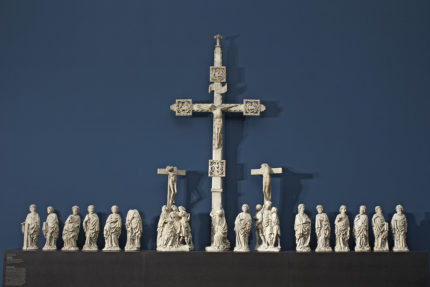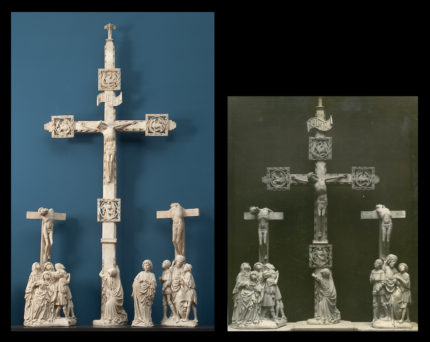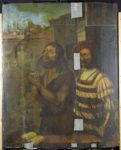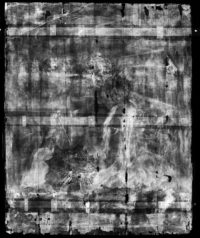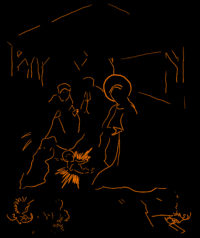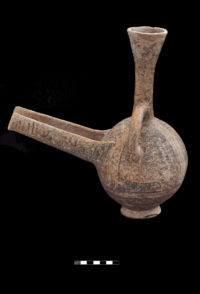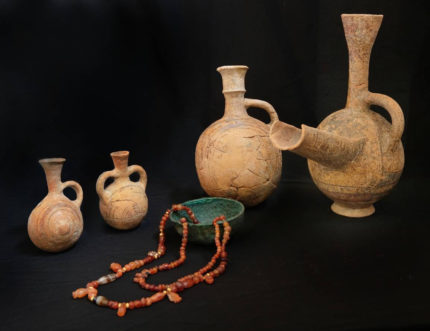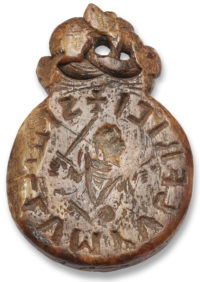The Rimini Altarpiece, a masterpiece of late medieval figural sculpture that is the highlight of Frankfurt’s Liebieghaus Skulpturensammlung, is undergoing a comprehensive multi-year conservation project that will restore the luminous transparency of the alabaster it was made out of and repair the damage done by past invasive restoration attempts.
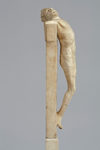 The altarpiece consists of 18 white alabaster figures and groups depicting the Crucifixion and apostles. The centerpiece is a very high crucifix with the figure of Mary Magdalen at its base hugging the cross. Flanking it are the two thieves, much smaller in scale. At the base of the left thief are the three Maries, the Roman soldier Longinus who speared Christ in the side and a servant. The base of the right thief features Stephaton, the man who offered Jesus the sponge soaked in vinegar, a centurion and a bare-footed youth. A freestanding figure of John the Baptist stands by the group. The 12 apostles, each individually carved, stand on both sides of the Calvary groups.
The altarpiece consists of 18 white alabaster figures and groups depicting the Crucifixion and apostles. The centerpiece is a very high crucifix with the figure of Mary Magdalen at its base hugging the cross. Flanking it are the two thieves, much smaller in scale. At the base of the left thief are the three Maries, the Roman soldier Longinus who speared Christ in the side and a servant. The base of the right thief features Stephaton, the man who offered Jesus the sponge soaked in vinegar, a centurion and a bare-footed youth. A freestanding figure of John the Baptist stands by the group. The 12 apostles, each individually carved, stand on both sides of the Calvary groups.
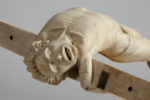 Traces of surviving pigment have been found on the white alabaster attesting to it having been partially polychrome originally. This Master of the Rimini Altarpiece embraced the idealized forms of the International Gothic style while also incorporating the anatomical realism of the Renaissance, in the contorted arms and bodies of the crucified thieves flanking Christ, for example. It was carved in the round and mounted in a framework, now lost, to display its exceptionally detailed carving on the church altar. Without the framework, scholars don’t know how it was originally arranged.
Traces of surviving pigment have been found on the white alabaster attesting to it having been partially polychrome originally. This Master of the Rimini Altarpiece embraced the idealized forms of the International Gothic style while also incorporating the anatomical realism of the Renaissance, in the contorted arms and bodies of the crucified thieves flanking Christ, for example. It was carved in the round and mounted in a framework, now lost, to display its exceptionally detailed carving on the church altar. Without the framework, scholars don’t know how it was originally arranged.
It was carved by a specialist alabaster workshop in Northern France or the Southern Netherlands in around 1430 to adorn the altar of the church of Santa Maria delle Grazie in Rimini. It remained in the church until 1910 when the Franciscans brothers sold it to an antiques dealer in Rome. The museum acquired it from him in 1913.
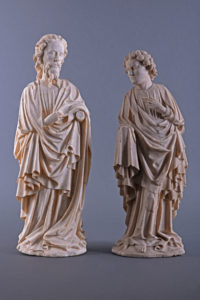 As unique and important as it is, the altarpiece has not been very well conserved. The last time it received thorough treatment was in the late 1960s, but the materials they used have discolored, penetrating the stone and making it more and more brittle.
As unique and important as it is, the altarpiece has not been very well conserved. The last time it received thorough treatment was in the late 1960s, but the materials they used have discolored, penetrating the stone and making it more and more brittle.
Above all, however, the last restoration involved a massive alteration to the very structure of the altarpiece. For purely aesthetic and subjective reasons based on art-historical considerations – but justifiable neither objectively nor in terms of art technology – the original appearance of the central Crucifixion group was substantially altered. Using model plaster and iron reinforcements, the upright element of the cross was lengthened by more than half a metre and the crossbeam by several centimetres. And this is not only an aesthetic problem: the materials chosen at the time now confront us with extremely serious conservation problems, as they have led not only to extensive corrosion but also to a dramatic loss of stability. As a result, the object is almost impossible to move without risk of damage, although the changing exhibitions at the Liebieghaus make it absolutely necessary to move it. In addition, the fragility of the cross has made it quite impossible for the piece to be lent to other museums, enabling it to be shown in other countries.
Lastly, no fundamental technological analysis of the ensemble has ever been carried out. In the work on the “Rimini Altarpiece” that has now begun and is scheduled to take place over the next two or three years, the initial task will be to carry out and document a precise technological examination of the entire ensemble in preparation for its restoration. This will include, among other things, a meticulous analysis of the present condition of the stone as well as an examination of the figures for traces of the earlier polychromy, likewise a measure that has not been systematically undertaken before.
As alabaster is one of the most sensitive types of stone, which immediately rules out many of the standard methods of restoration, several series of tests will first have to be carried out in order to ensure the object’s gentlest possible restoration. For visitors to the museum there will be a conservation studio on view, complemented by a film and also, in due course, glass cases with educational material, while on our website we will publish results of the ongoing research and restoration. In these various ways, we aim to enable interested members of the public to follow and share in all the further phases of the work as the project progresses.
